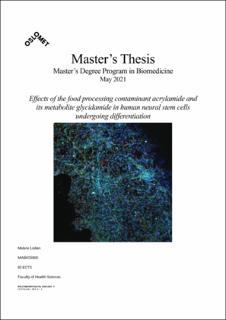| dc.description.abstract | Occupational exposure to the acrylamide (AA) monomer has been known since the 1960s to cause neurotoxicity of the central and peripheral nervous system. Concerns regarding exposure of the general populations arose upon discovering its natural formation in heated foodstuffs. AA is classified as a probable human carcinogen in addition to exhibiting genotoxic, reproductive, and developmental neurotoxic properties in experimental models. Adverse neurodevelopmental cognitive effects seen in animals have not yet been confirmed in humans. When absorbed from the gastrointestinal tract AA is metabolized mainly in the liver by CYP2E1 to glycidamide (GA). Both AA and GA are hydrophilic with wide distribution to organs and tissues. AA can reach the developing fetus via placental transfer and breast milk and prenatal exposure during pregnancy is associated with restricted fetal growth. It is unknown whether neurotoxicity is caused by AA itself or by GA. In this thesis, neural stem cells (NSCs) derived from human induced pluripotent stem cells were used to investigate the possible effect of exposure of AA and GA on key neurodevelopmental processes assessed by viability measurements, gene expression, and protein markers. The NSCs were differentiated and exposed to AA and GA (1x10-8 – 3x10-3 M) for up to 21 days. Effects on cell viability were measured using Alamar Blue™ Cell Viability assay upon exposure for 1, 3, 14, and 21 days. Alterations in gene expression of five genes were assessed using real-time PCR after exposure for 3, 14, and 21 days. Protein expression was qualitatively examined using immunocytochemistry and high content imaging after exposure for 14 and 21 days. The NSC cultures differentiated as expected, judged by changes in morphology seen in phase-contrast microscopy, gene, and protein expression of unexposed cells. Exposure to AA and/or GA at 1x10-8 M resulted in increased viability, whereas millimolar concentrations induced cytotoxicity in a time- and concentration-dependent manner. No statistically significant alterations in gene expression were observed. However, some trends were found although these may be of limited biological relevance. Expression of the astrocyte marker GFAP was not detected and should be further investigated using immunocytochemistry. Protein expression of neurodevelopmental markers did not reveal large differences in fluorescence intensity upon exposure. In conclusion, exposure to human-relevant concentrations of AA and GA increased cell viability with the most apparent effects for immature neurons, whereas higher concentrations resulted in cytotoxicity. Statistically significant alterations in the selected gene or protein expression of markers related to neurodevelopment were not observed. | en_US |
